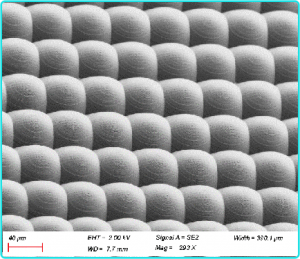
Micro and Nano Processing | Photolithography - Nanoimprint Lithography
Nanoimprint Lithography (NIL)It is very simple to describe. A mold (stamp) is first constructed with surface relief features and then pressed onto a polymeric material to transfer the pattern. The polymer material is usually a sacrificial resist film, which is used as a mask to etch the substrate or film below.
There are several different methods of NIL. Hot-press NIL uses elevated temperatures to soften the polymer film, allowing it to flow and fill around the surface relief, and then remove the stamp when it cools to room temperature.This is also known as hot embossed lithography.
Another variant uses UV light to crosslink and harden polymer films. Using a flexible liquid film, the film is exposed to UV light during the imprinting process. UV-NIL requires that the substrate and/or impression be transparent to UV wavelengths (e.g. quartz).
The main advantage of the NIL is the extreme simplicity of the process. There are no expensive optics, ultra-high vacuum chambers, electron beams or excimer lasers. Once the resist film has been patterned by photolithography, a chemical process is used to transfer the pattern to the substrate or film below. This is the pattern transfer process. There is also no basic resolution limit for Feature Size.
We offer fastMEMS device / micro and nanostructure processing design services, Feel free to leave a message to inquire.


